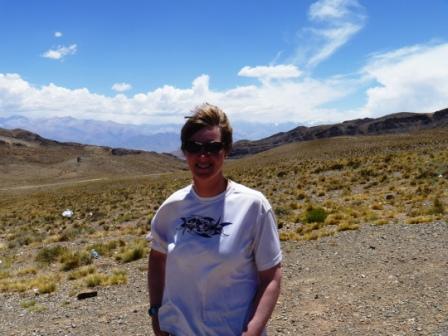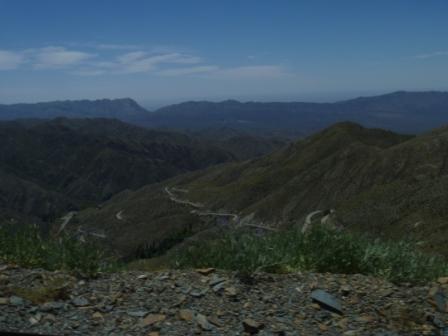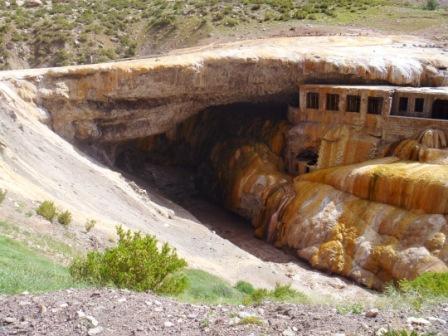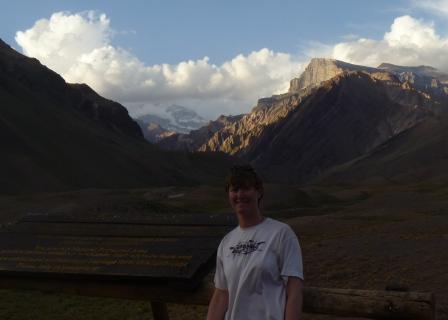Dirt roads in the High Andes

I was getting myself organised in Mendoza to take an afternoon bus to Punta del Inca but was concerned about finding a place to stay and getting a bus back to Uspallata. Then a Belgium couple who had been up at the hostel in the mountains for new years came in and we were talking about what we were all going to do in the next few days. They were renting a car they said in 15 minutes and heading for Punta del Inca. So I asked if they would be willing to take me along if I paid for part of the rental car. The bus was about 10% of the cost of a rental car but they were going to be going over the old dirt road instead of HW 7 which I have been up and down three times now. So throwing caution to the wind I thought I would be certain of finding a place to stay or there would be room in their hostel. I had to get out of mendoza as it was 38.5C around 101F.
Sten and Heather are from a village outside Antwerp. They have been travelling for 4 weeks and are coming to the end of their 5 week trip. Sten works for 3m as a chemist designing all the glues I used on the race boats and Heather in water treatment as an engineering designing the sewage pipe lines.

Anyways we headed for Uspallata and the road quickly became very winding. We were on
the ancient colonial road leading to Chile that was built in the XVI century. In San Martin’s time it was the only road available for ordinary travelers and for San Martin’s forces. It was important for the development of the mineral fields in the area. The English naturalist Charles Darwin, amoung other famous travelers, visited the area in 1835 and discovered the fossil remains of petrified araucarias in the area of Curva de los Ingleses. Various archeological sites with remains of primitive hunter peoples are found along the road.

Along the way there were quite a few small shrines and when we got on the high plains the temperature thankfully dropped to a more bareable 22C (72F). There were quite a few animals – cattle, a fox like creature that ran across the road in front of us, a llama/alpaca type animal and numerous small colorful birds.

The vegetation was thorn bushes and cactuses. The earth is very red and generally it is quite a bleak arid landscape. I believe we climbed to about 4000m before dropping down into the lush green valley of Uspallata.

After a picnic stop at Uspallata we continued onto Punta Del Inca passing Penitentes which is where we start our Aconcaua expedition. Unfortunately you can’t enter the Punta del Inca site as it is unstable.

There are trinket vendors including items that have been left to be covered with the minerals leaching out of the hillside.

We continued on route 7 to the Chilean Argentine border but instead of heading through the tunnel we took the old road to see the statue of Jesus. Running alongside the road is the old train line. Just after turning off to start the 1000m ascent up another winding dirt road we saw some people pulled to one side whose car was 5 years old and the coolant hose had exploded they were attempting to limp all the way back to Mendoza with a 2L soda bottle attached to the engine full of water. We checked all the fluids in the engine of the rental car and filled up our water bottles with water just in case.

These mountain range huts were colonial shelters for travelers, messengers and post men. Mr O’Higgins had them built in the XVIII century. They were scattered along the Royal Road and four fo them were in Argentina’s Andean mountains.
This road had existed since pre hispanic times. Huarpe Aborigines, Incas, discovers of Cuyo and founders of their cities, missionaries, travelers, postmen and traders travelled along it. On February 2nd 1817, the troops of the military division headed by Cnel Las Heras and under the command of General San Martin followed this road to liberate Chile from the Spanish.

Cuyo’s Archbishop, Marcolino Benavente, built a statue to pay homage to Jesus Christ, the Redeemer, once the dispute over the borders with Chile had been solved with the Pacts of May 1902. It was decided to place it at the border line between the two countries as a symbol of continental unity and peace. The monument, a work by the Arentinian sculptor Mateo Alonso, was inaugurated on March 13th 1904, on Santa Elena Mount at 4000m.

At 4000m on the border between Chile and Argentina looking down into Argentina.

We headed back down and stopped at the gate to Aconcaqua park. The peak is in the clouds up the valley behind me.

By the time we got back to Uspallata it was 9:30pm and as the hostel was towards Mendoza we stopped off to eat and by the time we got to the hostel it was 11:45pm. Sten and Heather had a reservation but the hostel was full so I spent the night sleeping in the car!

